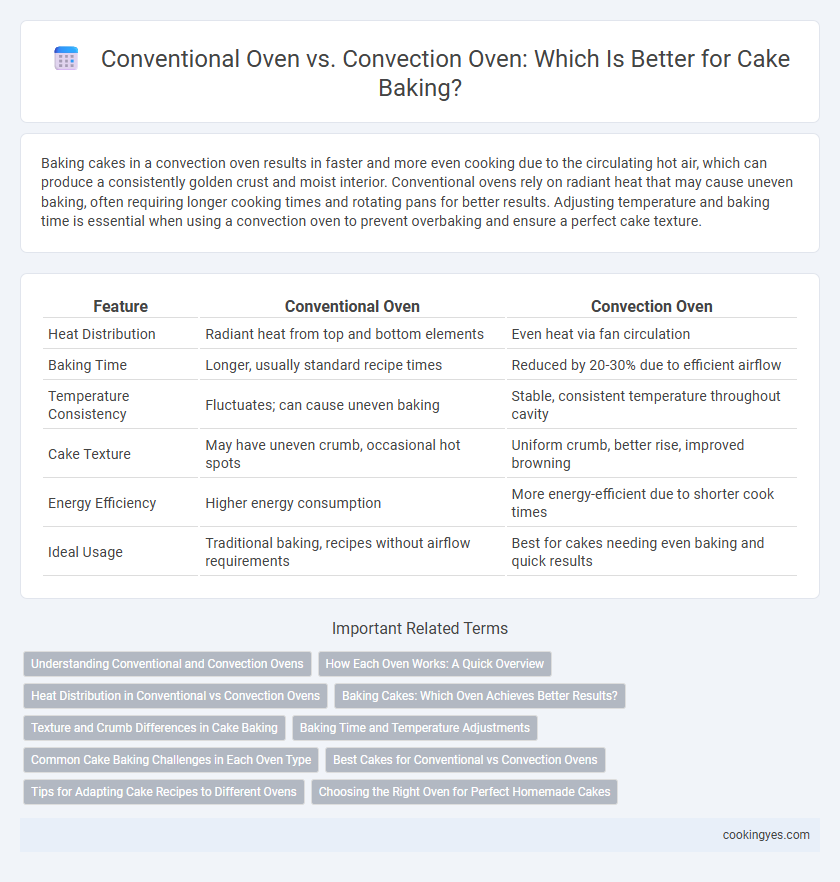Baking cakes in a convection oven results in faster and more even cooking due to the circulating hot air, which can produce a consistently golden crust and moist interior. Conventional ovens rely on radiant heat that may cause uneven baking, often requiring longer cooking times and rotating pans for better results. Adjusting temperature and baking time is essential when using a convection oven to prevent overbaking and ensure a perfect cake texture.
Table of Comparison
| Feature | Conventional Oven | Convection Oven |
|---|---|---|
| Heat Distribution | Radiant heat from top and bottom elements | Even heat via fan circulation |
| Baking Time | Longer, usually standard recipe times | Reduced by 20-30% due to efficient airflow |
| Temperature Consistency | Fluctuates; can cause uneven baking | Stable, consistent temperature throughout cavity |
| Cake Texture | May have uneven crumb, occasional hot spots | Uniform crumb, better rise, improved browning |
| Energy Efficiency | Higher energy consumption | More energy-efficient due to shorter cook times |
| Ideal Usage | Traditional baking, recipes without airflow requirements | Best for cakes needing even baking and quick results |
Understanding Conventional and Convection Ovens
Conventional ovens heat food by surrounding it with hot air from the bottom and/or top heating elements, creating a steady but sometimes uneven temperature ideal for classic cake textures. Convection ovens use a fan to circulate hot air evenly, resulting in faster, more uniform baking and a consistent golden-brown crust on cakes. Understanding these differences helps bakers choose the right oven type to achieve the desired cake moisture and rise.
How Each Oven Works: A Quick Overview
Conventional ovens use radiant heat from the top and bottom elements, creating a slower and uneven heat distribution that can cause cakes to bake inconsistently. Convection ovens feature a built-in fan that circulates hot air throughout the oven cavity, promoting even heat distribution and faster, more uniform baking. This airflow improves browning and texture, making convection ovens ideal for delicate cakes that require precise temperature control.
Heat Distribution in Conventional vs Convection Ovens
Heat distribution in conventional ovens relies on radiant heating from the oven walls, often resulting in uneven temperature zones that can cause cakes to bake unevenly. Convection ovens use a fan to circulate hot air consistently, promoting uniform heat around the cake batter and ensuring more even browning and rising. This enhanced airflow helps maintain consistent baking temperatures, reducing hotspots and improving overall cake texture and appearance.
Baking Cakes: Which Oven Achieves Better Results?
Convection ovens provide more even heat distribution for baking cakes, resulting in consistent texture and faster cooking times compared to conventional ovens. Conventional ovens rely on radiant heat, which can cause uneven baking and requires longer preheating. For achieving moist, evenly baked cakes with a golden crust, convection ovens are generally the superior choice.
Texture and Crumb Differences in Cake Baking
Conventional ovens bake cakes by surrounding them with steady, radiant heat, resulting in a denser crumb and a moister, thicker texture due to slower heat distribution. Convection ovens utilize a fan to circulate hot air, promoting even baking and producing a lighter crumb with a more uniform texture, often yielding a slightly crisper crust. The airflow in convection baking encourages faster moisture evaporation, which can lead to a drier, airier interior compared to the traditionally soft, compact crumb from conventional ovens.
Baking Time and Temperature Adjustments
Convection ovens bake cakes faster by circulating hot air evenly, typically reducing baking time by 25% and requiring a temperature decrease of 25degF (about 15degC) compared to conventional ovens. Conventional ovens rely on radiant heat, necessitating longer baking times and consistent temperatures usually set between 325degF to 350degF (163degC to 177degC) for most cakes. Adjusting temperature and time when switching between oven types ensures optimal cake texture and prevents overbaking or uneven cooking.
Common Cake Baking Challenges in Each Oven Type
Conventional ovens often cause uneven baking in cakes due to hot spots, leading to dense or undercooked centers and overbaked edges. Convection ovens circulate hot air, which can cause cakes to rise too quickly and crack or dry out if baking times and temperatures are not adjusted properly. Both oven types require careful temperature management and monitoring to achieve moist, evenly baked cakes.
Best Cakes for Conventional vs Convection Ovens
Conventional ovens provide steady, radiant heat ideal for baking delicate cakes like sponge and chiffon, ensuring even rising and a tender crumb. Convection ovens distribute hot air via a fan, producing faster, more even baking that suits denser cakes such as pound and bundt cakes by creating a crisp exterior and moist interior. Choosing the right oven impacts texture and baking time, with conventional ovens preserving moisture in airy cakes and convection ovens excelling in browning and firmness for rich, heavy batters.
Tips for Adapting Cake Recipes to Different Ovens
When adapting cake recipes for conventional ovens, increase the baking temperature by 25degF and extend the baking time by 5-10 minutes to ensure even cooking. Convection ovens require lowering the temperature by 25degF and reducing baking time by about 25%, as the fan circulates hot air for consistent heat distribution. Use an oven thermometer and test cakes early with a toothpick to prevent under- or over-baking regardless of oven type.
Choosing the Right Oven for Perfect Homemade Cakes
Convection ovens use a fan to circulate hot air, promoting even baking and faster cooking times, which enhances cake texture and color. Conventional ovens provide steady, radiant heat from the top and bottom, ideal for delicate cakes that require gentle, consistent warmth. Selecting the right oven depends on the cake type and baking goals, with convection ovens favored for layered and dense cakes, while conventional ovens benefit light and airy sponge cakes.
Conventional Oven vs Convection Oven for cake baking Infographic

 cookingyes.com
cookingyes.com